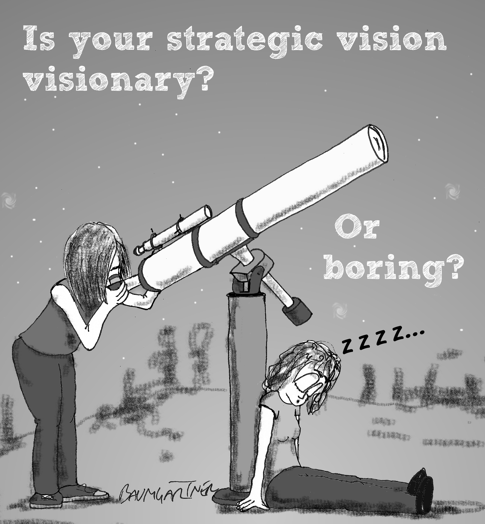
Is Your Strategic Vision Visionary or Boring?
By Jeffrey Baumgartner
Probably the most important sentence your company ever puts to paper is your strategic vision statement. It defines your organisation, your goals and the paths you take. A bold, visionary statement is the first step in establishing your firm as a bold, visionary leader. A mediocre statement keeps you on a path of mediocrity, trailing behind the visionary leaders. A lack of any vision leaves it to your customers and employees to assign a mediocre vision statement to your company. And they will.
Whether yours is a global organisation or a one-woman business operating out of Poughkeepsie, your strategic vision statement should be but a few words, but those words are vitally important to where your company is going and how it is going to get there. Think about the leading company or two in any field and you probably have a good idea of their strategic visions. Think about Apple, Walmart, Facebook, Versace, Porsche, Victoria's Secret.
In short, success for your business starts with a strategic vision statement and then flows through communication to your employees, customers, future customers, business partners, other stakeholders and your community.
Moving Goal
A vision statement is essentially a moving goal that you aspire to chase after. The moving bit is important. You do not ever want actually to achieve the goal defined in your vision. If your vision is to sell 100 coffee mugs by next Wednesday, you'll be lost come Thursday. On the other hand if your vision is to create unique, designer coffee mugs in limited batches of 100 which will only be sold for one week, you've got something that will keep you busy indefinitely.
Avoid Being Best Like the Plague
Amazingly, in view of the critical importance of a strategic vision statement, a large number of companies either have no defined vision or a vague, meaningless one. The worst thing you can do in crafting a strategic vision statement is to use the word "best" − it is almost certainly an indication of mediocrity and lack of vision. To understand why, the next time you are with a group of friends, ask everyone who makes the best pizza (or any popular food) in your city. The chances are you will get several different answers and a few disagreements. That's because best is a meaningless word unless precisely defined − and even then it is dubious.
Or, look at it this way, you are visiting a new city and see three pizzerias. One claims to be the best pizzeria. The other makes no claim and the third claims to be a family owned restaurant specialising in novel pizzas made with fresh locally sourced ingredients. Which is likely to get your business?
Be Different
No company ever became the market leader by being the same as everyone else in the field. Think about it. In order to have a field in which everyone is the same, there had to have been a visionary who defined normal behaviour in that field.
Your strategic vision statement should be unique. It should carve out your niche in the market place and allow you to own that niche. That can be scary. For most organisations, like people, it feels safer to follow the leader than to go off in your own direction. But you will know you have succeeded when you look back and find other companies following your lead.
Why?
So, why do you need a strategic vision statement? Why not just do business, make money and keep busy?
The truth is, you do not need a strategic vision statement. Your local chemist (drug store) is probably quite content to sell medicine, fill prescriptions and chat with regular customers. That will probably keep her and her staff in business, pay all of them a decent salary and, when she is ready to retire, she can sell the business in order to add to her pension fund. There is absolutely nothing wrong with that.
However, if she dreams of setting up new shops and eventually building a regional chain of chemists, she needs to be a bit visionary. There are probably already regional and national chains (depending on where she lives). How will she define her chain to be as different, in a good way, to the competition. What is the vision behind her dream?
Perhaps she wants to make it easier for ill people to get their prescription and non-prescription medication, so she defines the vision as providing medication when you need it and where you need it. From this, she might establish an on-line ordering system and a small fleet of vans that can process prescriptions and deliver medicine.
A unique strategic vision is necessary for:
- Establishing your position in the market place. Unless you have a unique strategic vision, you are just another player in a crowded market place. Ever heard of Jumex sneakers? How about Adidas sneakers?
- Innovation. Innovation only really succeeds when it is aligned with strategic vision which, of course, necessitates that you actually have a strategic vision. This is something I have written about in the past.
- Motivating employees. It is a lot more exciting to work towards a strategic vision than it is to just work. Communicating your strategic vision to the team helps excite them − provided it is an exciting vision. A vision along the lines of "we underpay and abuse employees to give our customers the lowest prices" will probably not motivate anyone besides sadistic customers.
- Motivating customers. People get excited about Apple's new products in ways that they fail to get excited about Dell's new products. People look forward to a Ben and Jerry's ice cream far more than they look forward to a Delhaize 365 (a Belgian supermarket brand) ice cream.
- Brand loyalty. I bought a Wiko Smartphone a couple of years ago because it was good value for money and the salesman recommended it. When it is time for a new telephone, I am unlikely to feel any compulsion to buy another Wiko unless it is still good value for money. I don't need a lot from my smartphone. On the other hand, I love my Subaru. When it is time to get a new car, my first choice for a new car will be a Subaru. I believe Subaru's strategic vision is super-durable, fantastic handling and rather boring looking cars for eccentrics. That works for me.
- Being a leader. We've already covered this point.
Easy for Start-Ups
It is much easier for a start up to define a strategic vision and then define the company around the vision. They are starting from scratch, so the market has no preconception of them − though it may have preconceptions about the kind of business the start up is.
It is much harder for an established company to redefine a mediocre vision. Even if you have not defined a vision for your company as such, the chances are your customers have a vision in mind. Perhaps your products are cheap. Perhaps your customers are mostly friends of friends. Perhaps you're the only company in the area providing a particular product or service and so your customers are stuck with you!
This has been a big issue for one-time state enterprises, such as telecommunications companies, electricity providers and postal services that have been privatised, subjecting these companies to competition for the first time ever. Prior to privatisation, state enterprises had no competition and no need for a strategic vision statement. Their customers all too often had a vision of inefficiency, mediocre products and shoddy customer service at a high price − not a winning strategy in a competitive market!
An established company defining or redefining a vision statement will have to make operational changes and communications changes in order to fit the new vision. It may have to sell off or discontinue product lines and lose customer groups that are not relevant to the new vision. A pillow manufacturer that has been making all kinds of pillows may decide to focus on ergonomic pillows made with the finest materials. This will mean dropping the cheap pillows and giving up on the customers who buy their pillows. This can be scary. No one wants to lose a set of customers. However, to establish yourself as a luxury brand, you cannot sell cheap things. Hanging on to the low end customers will cost you high-end customers.
My Experience
I redefined my company vision in 1995. I had set up a marketing communications company in Bangkok three years earlier. We had a small team and a handful of subcontractors and did all kinds of work, mostly printed: advertising, brochures, press releases and that kind of thing − but we were open to anything. In 1994, I became interested in the Internet and its potential. So, I added web development to our collection of services (and hastily looked at source code of other web pages in order to work out how to do it myself and train staff).
A few months later, I decided to drop the printed work and focus on becoming a pioneer in web and multimedia development. That vision seems broad now, but was very focused in 1995, especially in a developing economy like Thailand's. My decision meant losing some business opportunities, but it established us as a key player in a new and growing market. It was worth it. It was an early taste of professional fame. As an Internet and multimedia pioneer fluent in Thai, the local press often contacted me to ask about trends.
Just a Few Words
Your strategic vision statement should be short, sweet and clear. It should not require a great many words. Indeed, the fewer the better. But, those words will arguably be the most important words your company has ever put in writing. It is worth investing time, thought and expertise to the task. If your company is already established, you should almost certainly bring in an outsider who sees your company differently than you and the management team do.
And Communicate Them
Once you have a vision statement, it is critical to communicate it to employees, to stakeholders to the marketplace and to the community. A vision statement is pointless if no one is aware of it, and particularly if your employers are unaware of what they are meant to be working towards.
Once they are aware, use that vision to motivate them. Use that vision to drive innovation. Use that vision to drive marketing.. Use that vision to stand out in the marketplace not as a follower, but as a leader.
And just keep moving!




